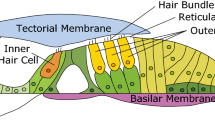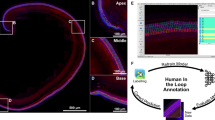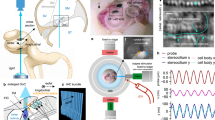Abstract
It is generally agreed that frequency selectivity of the mammalian hearing organ is mainly due to a graded elasticity of the basilar membrane1. Recent measurements of basilar membrane motion2,3, hair cell receptor potentials4 and neural tuning curves5 show that frequency selectivity can be extremely sharp. It has been suggested that in non-mammalian species there are additional tuning mechanisms in the sensory hair cells themselves, either by virtue of their electrical membrane properties6 or through a gradation in length of their sensory hairs7,8. Indeed, sensory hair mechanical tuning has been demonstrated in the lizard9. We have investigated the mechanical properties of sensory hair bundles in the guinea pig organ of Corti, and report here that hair-bundle stiffness increases longitudinally towards the high-frequency end of the cochlea, decreases radially towards the outer rows of cells, and is greater for excitatory than for inhibitory deflection. On the basis of these findings, we suggest that sensory hairs confer frequency-specific, nonlinear mechanical properties on the hearing organ.
This is a preview of subscription content, access via your institution
Access options
Subscribe to this journal
Receive 51 print issues and online access
$199.00 per year
only $3.90 per issue
Buy this article
- Purchase on SpringerLink
- Instant access to full article PDF
Prices may be subject to local taxes which are calculated during checkout
Similar content being viewed by others
References
von Békésy, G. Experiments in Hearing (McGraw-Hill, New York, 1960).
Khanna, S. M. & Leonard, D. G. B. Science 215, 305–306 (1982).
Sellick, P. M., Patuzzi, R. & Johnstone, B. M. J. acoust. Soc. Am. 72, 131–141 (1982).
Russell, J. J. & Sellick, P. M. J. Physiol., Lond. 284, 261–290 (1978).
Evans, E. F. in Handbook of Sensory Physiology Vol. 2 (eds Naunton, R. F. & Neff, W. D.) 78 (Springer, New York, 1975).
Crawford, A. C. & Fettiplace, R. J. Physiol., Lond. 312, 377–4l2 (1981).
Weiss, T., Peake, W. T., Ling, A. & Holton, T. in Evoked Electrical Activity in the Auditory System (eds Naunton, R. F. & Fernandez, C.) 91–112 (Academic, New York, 1978).
Turner, R. G., Muraski, A. A. & Nielson, D. W. Science 213, 1519–1521 (1981).
Holton, T. & Hudspeth, A. J. Science 222, 508–510 (1983).
Flock, Å. & Strelioff, D. Hearing Res. (in the press).
Strelioff, D. & Flock, Å. Hearing Res. (in the press).
Hudspeth, A. J. & Corey, D. P. Proc. natn. Acad. Sci. U.S.A. 74, 2407–2411 (1977).
Kemp, D. T. J. acoust. Soc. Am. 64, 1386–1391 (1978).
Siegel, J. H. & Kim, D. O. Hearing Res. 6, 171–182 (1982).
Author information
Authors and Affiliations
Rights and permissions
About this article
Cite this article
Flock, Å., Strelioff, D. Graded and nonlinear mechanical properties of sensory hairs in the mammalian hearing organ. Nature 310, 597–599 (1984). https://doi.org/10.1038/310597a0
Received:
Accepted:
Issue date:
DOI: https://doi.org/10.1038/310597a0
This article is cited by
-
Quo vadis, hair cell regeneration?
Nature Neuroscience (2009)
-
Stereocilin-deficient mice reveal the origin of cochlear waveform distortions
Nature (2008)



